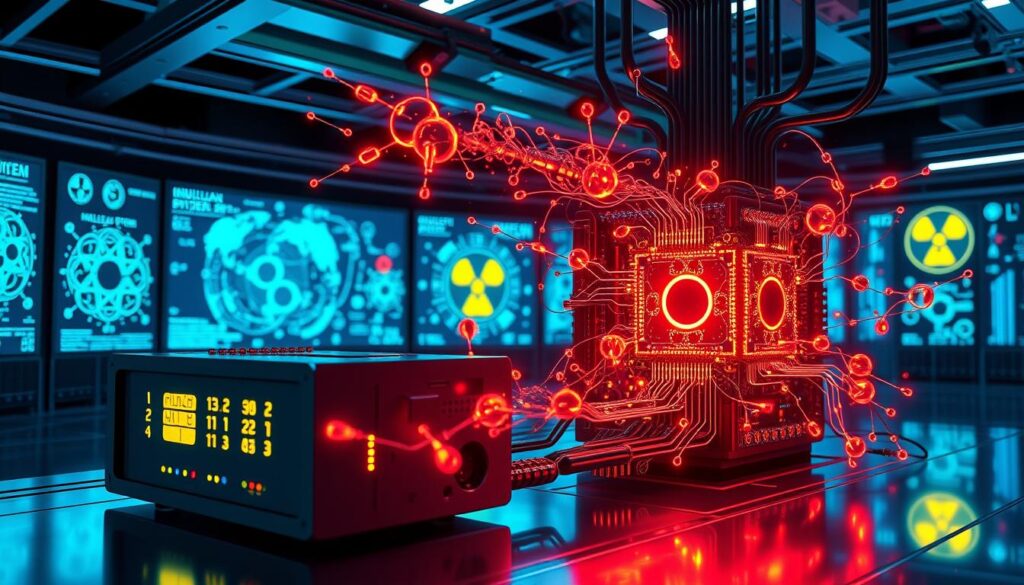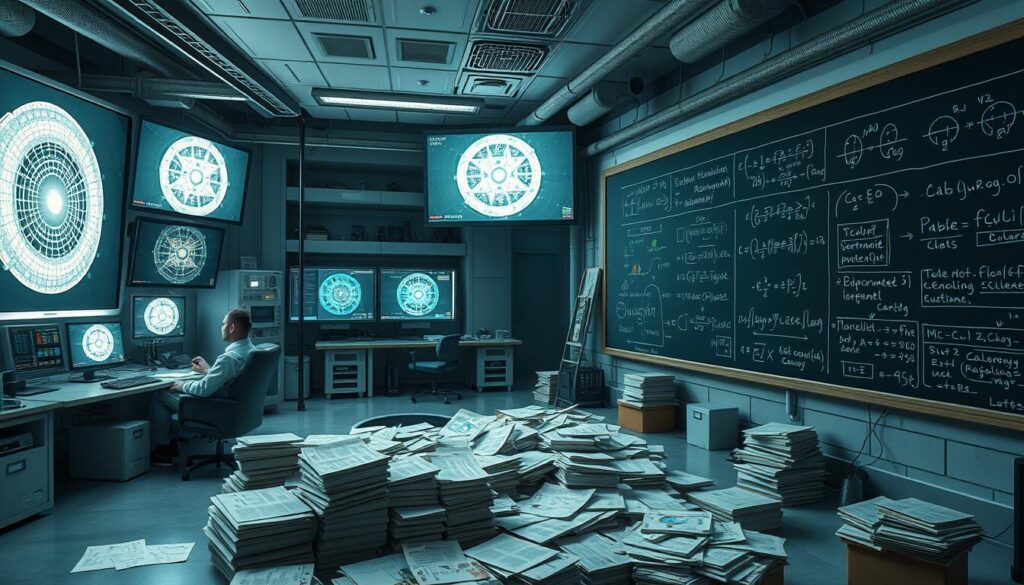Quantum computing is transforming the field of nuclear energy simulation, offering sustainable and efficient solutions. It uses quantum mechanics to model complex nuclear reactions with unmatched accuracy and power. This article explores how quantum algorithms can optimize nuclear energy systems, improve radiation safety, and lead to a greener energy future.
Traditional methods for simulating nuclear reactions face significant challenges due to their complexity. Quantum computing, however, brings a new era of capability. Quantum algorithms, utilizing qubits and entanglement, can tackle calculations that classical computers cannot. This quantum leap promises to enhance energy efficiency and ensure the safety of nuclear systems.
The Potential of Quantum Computing in Nuclear Energy
Quantum computing is a cutting-edge technology poised to transform industries, including nuclear energy. It leverages quantum mechanics to tackle complex calculations and simulations. This quantum leap could revolutionize nuclear power plants and nuclear energy research.
Quantum computing’s impact is significant in simulating nuclear reactions. These processes involve intricate subatomic particle interactions, governed by quantum mechanics. Classical computers struggle with these complex phenomena, requiring exponential computational resources. Quantum computers, however, can efficiently simulate these systems, offering deeper insights into nuclear reactions and optimizing reactor designs.

Quantum computing also has potential in optimizing nuclear power plant operations. These facilities require precise control and monitoring for safe and efficient operation. Quantum algorithms can optimize fuel management, reactor control, and waste disposal. This optimization can lead to increased energy output, reduced downtime, and lower environmental impact.
Furthermore, quantum computing can support the development of advanced nuclear technologies. Small modular reactors (SMRs) and fusion reactors are examples. SMRs are compact, scalable, and safer than traditional reactors. Quantum simulations can optimize SMR design for reliability and cost-effectiveness. Fusion reactors, promising limitless clean energy, also benefit from quantum computing’s ability to model plasma dynamics and optimize configurations.
The integration of quantum computing in nuclear energy could accelerate research and development. It opens new avenues in nuclear physics, materials science, and reactor engineering. This collaboration could lead to safer, more efficient, and environmentally friendly nuclear power plants. It’s a step towards a sustainable energy future.
Challenges in Traditional Nuclear Energy Simulation
Nuclear energy simulation through classical computing has long been crucial in reactor design and operation. Yet, these traditional methods face significant hurdles, affecting their accuracy and efficiency. The main issue lies in the computational limitations of classical systems. Modeling nuclear reactions’ complex quantum mechanical processes proves challenging with conventional algorithms and hardware.
To tackle these limitations, scientists use approximations and simplifications in simulating nuclear energy systems. While these methods make calculations more feasible, they introduce uncertainties and inaccuracies. This can result in suboptimal reactor designs and operational strategies, potentially compromising safety and efficiency in nuclear power plants.

Managing nuclear waste is another critical concern. Traditional simulation methods find it hard to accurately predict the long-term behavior and safety of waste repositories. The complexity of processes like radioactive decay and material interactions in storage poses significant challenges. Without reliable simulations, ensuring the safe and effective disposal of nuclear waste remains a major issue.
Safety concerns also hinder the broader adoption of nuclear energy. Despite nuclear power plants’ strong safety record, accidents or failures could have severe consequences. Traditional simulation methods may not fully capture all possible scenarios and risks in reactor operation. This limitation can hinder the development of robust safety measures and emergency response plans, eroding public confidence in nuclear energy.
To overcome these challenges, researchers are exploring quantum computing. Quantum computers, by harnessing quantum mechanics, promise to perform highly accurate and efficient simulations of nuclear energy systems. They aim to leverage the unique properties of quantum bits (qubits) and quantum algorithms to overcome classical computing’s limitations and approximations.
Quantum Algorithms for Nuclear Energy Simulation
Quantum algorithms are leading the charge in nuclear energy simulation. They use quantum systems’ unique traits, like superposition and entanglement, to tackle complex nuclear problems. This approach allows for the precise simulation of subatomic particle behavior.
Quantum circuit design is a cornerstone in this field. Researchers craft innovative circuits to accurately depict nuclear and electron interactions. These circuits aim to reduce errors and enhance simulation precision, leading to more accurate nuclear reaction predictions.
Quantum chemistry is vital in nuclear energy simulation. Quantum algorithms applied to chemical reactions at the atomic and molecular level offer profound insights. This knowledge is crucial for enhancing reactor performance, fuel efficiency, and waste reduction.
Nuclear physics also benefits greatly from quantum algorithms. These simulations allow for the study of subatomic particles under extreme conditions, akin to nuclear reactor cores. By accurately modeling these interactions, quantum algorithms improve nuclear reaction outcome predictions.
The aim is to achieve the highest simulation accuracy with quantum algorithms. Quantum computing’s power enables simulations far more precise than classical methods. This precision leads to more reliable reactor performance, enhanced safety, and more efficient nuclear energy technologies.
As quantum algorithms evolve, they promise to transform nuclear energy simulation. They offer unparalleled insights into reactor processes, paving the way for clean, safe, and sustainable nuclear energy.
Simulating Nuclear Reactions for Energy Using Quantum Computing
Quantum computing is transforming nuclear energy by simulating complex nuclear reactions with high accuracy. It uses quantum algorithms to model both fission and fusion reactions with unmatched precision. This innovation could significantly improve energy generation and speed up the creation of next-generation nuclear reactors.
In nuclear fission, quantum computing enables detailed modeling of reactor dynamics and fuel usage. It simulates the quantum-level interactions of neutrons and fissile materials. This offers insights into optimizing reactor performance, leading to more efficient and safer nuclear plants.
Quantum computing also opens new paths for studying nuclear fusion. Fusion, the energy source of the sun and stars, is promising for its limitless and clean potential. Yet, achieving controlled fusion on Earth has been a major hurdle. Quantum simulations can tackle the complexities of plasma dynamics and energy extraction in fusion reactors. This could expedite the development of practical fusion technology, moving us towards a sustainable energy future.
The use of quantum computing in nuclear energy simulation brings several benefits:
- Enhanced accuracy: Quantum algorithms capture the quantum-mechanical aspects of nuclear reactions, offering more precise predictions than classical simulations.
- Increased computational efficiency: Quantum computers can solve certain problems exponentially faster than classical computers, allowing for simulations of larger and more complex nuclear systems.
- Optimization of reactor design: Quantum computing can simulate various reactor configurations and operating conditions, guiding the design of more efficient and safer reactors.
- Accelerated fusion research: Quantum simulations can help overcome the challenges in fusion reactor development, potentially leading to practical fusion power.
As quantum computing evolves, its influence on nuclear energy simulation will expand. The combination of these fields could revolutionize energy generation, leading to a cleaner, more sustainable, and abundant energy future. Quantum computing is poised to play a vital role in optimizing nuclear fission reactors and unlocking fusion secrets, marking a new era in energy innovation.
Advantages of Quantum Computing in Nuclear Energy Simulation
Quantum computing brings significant benefits to nuclear energy simulation, surpassing traditional methods. It uses quantum algorithms to cut down on the time needed for complex simulations. This leads to quicker and more detailed analysis of nuclear systems, driving faster progress in the field.
Quantum simulations also enhance safety in nuclear energy production. They help identify and mitigate risks and uncertainties more effectively. This ensures the safe operation of reactors, reducing the chance of accidents. Such safety measures protect workers, the environment, and boost public trust in nuclear energy.
Furthermore, quantum computing can significantly reduce costs in nuclear energy simulation. It optimizes reactor designs and operations, leading to cost savings. This includes more efficient fuel use, longer reactor lifetimes, and lower maintenance costs. These improvements make nuclear energy more economically viable.
The environmental benefits of quantum computing in nuclear energy simulation are immense. As we move towards cleaner energy sources, nuclear power can play a key role in reducing emissions. Quantum simulations aid in developing advanced reactor designs that minimize waste and improve environmental performance. By leveraging quantum computing, we can make nuclear energy safer and more sustainable, paving the way for a greener future.
Current Research and Developments
Research institutions, government agencies, and private companies are pushing the boundaries of quantum computing in nuclear energy simulation. They focus on developing quantum hardware and software, as well as forming industry collaborations. The aim is to integrate quantum technologies into nuclear energy, enhancing efficiency and accuracy in simulations.
Quantum algorithms for nuclear reactor design optimization are a major area of research. These algorithms aim to improve simulation efficiency and accuracy. They could significantly reduce costs and offer deeper insights into reactor performance and safety.
Quantum computing is also being explored for simulating nuclear waste disposal scenarios. This is crucial for the industry, as it helps predict radioactive material behavior. Accurate modeling can lead to safer and more sustainable waste management strategies.
Efforts are also directed towards creating specialized quantum hardware and software for the nuclear industry. This includes designing quantum processors for simulation tasks and developing user-friendly software frameworks. These advancements are essential for practical application in nuclear energy.
Collaboration is vital in advancing quantum computing for nuclear energy simulation. Partnerships between research institutions, industry, and government agencies accelerate innovation. Joint projects and knowledge-sharing initiatives are key to realizing quantum computing’s benefits across the industry.
Researchers are also exploring new applications, like quantum-enhanced sensors for radiation detection. These sensors promise unparalleled sensitivity and accuracy. Their integration could transform radiation monitoring, ensuring safer nuclear facilities and personnel.
The ongoing research in quantum computing for nuclear energy simulation is setting the stage for a new era. By leveraging quantum algorithms, specialized hardware, and partnerships, the industry is ready to overcome traditional simulation limitations. This will open up new opportunities for safe, efficient, and sustainable nuclear energy production.
Future Outlook and Challenges
The future of quantum computing in nuclear energy simulation looks incredibly promising. It has the potential to transform the industry, leading to more sustainable and secure energy solutions. However, several challenges must be overcome to fully benefit from this technology. Scaling up quantum hardware to handle larger simulations is a major hurdle. This requires significant advancements in error correction and the development of fault-tolerant systems.
Workforce development is another critical challenge. As quantum computing becomes more integrated into the nuclear energy sector, there’s a growing need for skilled professionals. Educational institutions and industry partners must collaborate to develop comprehensive training programs. These programs should equip the next generation with the knowledge and skills needed to harness quantum computing in nuclear energy applications.
Establishing robust regulatory frameworks is also essential for the safe and responsible deployment of quantum-enhanced nuclear energy systems. Policymakers and industry stakeholders must work together to develop standards and guidelines. These should address the unique challenges and risks associated with quantum computing in the nuclear energy context. By addressing these challenges and investing in research and development, we can unlock quantum computing’s full potential. This will revolutionize nuclear energy simulation and contribute to a more sustainable energy future.
